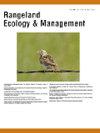Spread of Forage Kochia in Invasive Annual Grass-Dominated Sagebrush Steppe
IF 2.4
3区 环境科学与生态学
Q2 ECOLOGY
引用次数: 0
Abstract
Forage kochia (Kochia prostrata (L.) Schrad.) is a nonnative, semi-shrub that has been seeded in the western US to improve forage and habitat value of nonnative grasslands, compete with invasive plants, and as green-strips to reduce wildfire spread. As with other introduced plants, there are concerns that it may spread from areas it has been seeded. Current information on the potential for forage kochia to spread are inconclusive and reported results contradict each other. Thus, empirical studies investigating its spread over long-term (10 yr) periods of time are needed to guide land management decision. We investigated the spread of “Snowstorm” forage kochia at 11 invasive annual grass-dominated plant communities in southeastern Oregon a decade after they had been seeded. The seeding boundary was permanently marked at the time of seeding to ensure accurate measurements of forage kochia spread. Forage kochia established beyond the seeding boundary at two of the 11 seeded sites. The maximum distance that forage kochia spread from the seeding boundary was 65 cm. These results suggest that forage kochia does not readily spread in annual grass-dominated sagebrush steppe and what little spread it exhibited was over a relatively short distance. The risk of forage kochia spreading and dominating annual grass-invaded rangelands, at least in this region, appears minimal. Additional investigations of forage kochia spread in different environments and across various plant communities is warranted to inform land managers of any potential risks. Multiple decades evaluations of its potential to spread would also be important. Even though additional research would be valuable, our results that forage kochia does not readily spread suggest it may be a relatively safe option to seed to diversify nonnative grasslands.
禾草型山艾灌丛入侵一年生草原中草料小蠊的传播
草料kochia prostrata (L.)Schrad.)是一种非本地的半灌木,已在美国西部播种,以提高非本地草地的饲料和栖息地价值,与入侵植物竞争,并作为绿带减少野火蔓延。与其他引进植物一样,人们担心它可能会从已经播种的地区传播开来。目前关于草料kochia传播潜力的信息是不确定的,报告的结果相互矛盾。因此,需要对其在长期(10年)内的传播进行实证研究,以指导土地管理决策。我们调查了俄勒冈东南部11个入侵的一年生草为主的植物群落中“暴风雪”草料kochia在播种10年后的传播。播种边界在播种时被永久标记,以确保准确测量草料kochia的传播。在11个播种地中,有2个播种地在播种地边界外出现了草料kochia。草料小红花离苗界的最大传播距离为65 cm。这些结果表明,草食草在一年生草为主的山艾草草原上不容易传播,传播的距离相对较短。草料kochia蔓延和主导一年生草入侵牧场的风险,至少在本地区,似乎很小。有必要对不同环境和不同植物群落中草料kochia的传播进行进一步调查,以告知土地管理者任何潜在的风险。几十年来对其传播潜力的评估也很重要。尽管进一步的研究是有价值的,但我们的研究结果表明,草料kochia不容易传播,这可能是一种相对安全的选择,可以使非原生草地多样化。
本文章由计算机程序翻译,如有差异,请以英文原文为准。
求助全文
约1分钟内获得全文
求助全文
来源期刊

Rangeland Ecology & Management
农林科学-环境科学
CiteScore
4.60
自引率
13.00%
发文量
87
审稿时长
12-24 weeks
期刊介绍:
Rangeland Ecology & Management publishes all topics-including ecology, management, socioeconomic and policy-pertaining to global rangelands. The journal''s mission is to inform academics, ecosystem managers and policy makers of science-based information to promote sound rangeland stewardship. Author submissions are published in five manuscript categories: original research papers, high-profile forum topics, concept syntheses, as well as research and technical notes.
Rangelands represent approximately 50% of the Earth''s land area and provision multiple ecosystem services for large human populations. This expansive and diverse land area functions as coupled human-ecological systems. Knowledge of both social and biophysical system components and their interactions represent the foundation for informed rangeland stewardship. Rangeland Ecology & Management uniquely integrates information from multiple system components to address current and pending challenges confronting global rangelands.
 求助内容:
求助内容: 应助结果提醒方式:
应助结果提醒方式:


